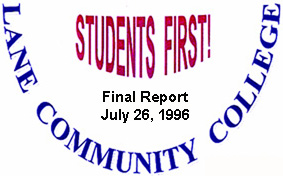| Lane Home Page | Search Lane |
| Website Accessibility |

STUDENTS FIRST! PROCESS REDESIGN Return to Change Proposal List SERVICE: Information Dissemination - Student Database Linking Current Situation: The mainframe student database includes basic demographic, financial and transcript information for both credit and non-credit students. It is used for multiple functions including conducting transactions, obtaining student information, and advising a student. Limited capabilities of existing databases do not allow all transactions to be entered directly into the system resulting in the creation of additional databases as well as alternative methods of recordkeeping. In addition, several departments are unable to input information necessary for mandated Federal and State reporting. Insufficient disc space led to the purging of thousands of credit and non-credit student records from the database that are now stored by microfiche and microfilm. Since 1992, the purging of participating credit students has ceased. The ability to conduct student related transactions on the database is limited. Employees at the outreach centers do not have the authority to accept payment on-line for students or make financial adjustments. Payments made by credit card can not be processed on-site. The payment processing and information entry is postponed at least a day so that it can be processed on the main campus. Student payment resolution is delayed and funds are handled multiple times to process a single transaction. Employees depend on the information provided on the database to provide services to students. In order to provide their students answers to basic questions, the Florence Outreach Center estimates making thirty telephone calls a day to the main campus. In the OSRL survey, thirty-six percent of respondents take non-credit courses and approximately two and one-half percent are taking both credit and non-credit courses. However, employees on the main campus are unable to access course information for students taking non-credit courses. According to input gathered in individual interviews with employees representing Adult Basic and Secondary Education, Continuing Education, Business Development Center, Business and Industry Services, and Training and Development, six duplicate databases were identified in addition to the main student database. In the ABSE department, employees may enter identical data up to three times. During input sessions, employees commented that student information changes can go undetected because no connection exists between duplicate databases. Students in ABSE, LEAP and GED programs are unable to access their unofficial transcripts or schedules from ATLAS. Students have multiple records with inconsistent information and all available student information has been hard to locate. The Student Records Office from July 1995 -1996 merged approximately four hundred multiple student records. There is limited capability to cross-check student information between the database and other record keeping systems. Lane discovers student record errors by relying on undelivered mail and by the student or employees stumbling across the errors in the records. Outreach Centers as well as main-campus departments keep paper files of student records. Some paper record keeping is federally or state mandated. The Florence campus keeps paper files to ensure student financial transactions conducted on-site are reflected later by the main-campus. Desired Situation: All student record information will be linked. Employees at various locations will be empowered to conduct transactions and increase overall service to students. Employees can access complete information on a student without taking many unnecessary steps to find needed information. Independent alternative data bases created to meet needs unmet by the current databases will not exist. All data will be entered only once. Proposed Solution: The Information Planning Team will coordinate, advise, and consult a group of programmers who will dedicate a portion of their time to linking databases. The team will identify additional members for this project including: one redesign team member, one computer services programmer, three multiple database users from different departments. They will work with the programmers beginning with the initial design through the testing and debugging of the system up to its implementation. Input from the Linn-Benton Community College outreach center employees shared increased satisfaction with the ability to access all student information as well as processing transactions for students. Additional employees, in particular, the Students First! Center Team will be trained to conduct various transactions currently limited to specific departments. Employees college-wide will have additional abilities to a majority of student related information. Departments using alternative methods of student information record keeping, and computer services will be involved in creating a system that meets the various record keeping needs. All databases will be linked to the main database in a user-friendly system that can be accessed college-wide. Employees will be able to access student information and students in departments not currently linked to the database will also have better access through alternative means to get their records.
Coach (from Redesign Team): Ray Smith
Action Plan For Implementing Solution:
Return to Part Five of the Redesign Change Proposals |
>> Return to Lane's Home Page >> Return to Process Redesign Project Main Page >> Return to top of page Lane Community College - Process Redesign Project 4000 East 30th Avenue, Eugene, OR 97405 Please direct comments about this site to webmaster@lanecc.edu Revised 12/2/96 (llb) © 1996-present Lane Community College |
